Tours & Travels
With the grace and help of God the pilgrims are now in Mak`kah and have also performed Umrah. Some of the pilgrims go to Madina-tul-Munawwara before hajj while the others after the hajj. The movement is scheduled by concerned Muallim (The hajj guide) Those who proceed to Madina before hajj are advised to carry minimum possible and only very essential items of daily use to stay in Madina. Yet they must carry a set of Ehram since while returning from Madina to Mak`kah there is a Meeqat in between and one can not pass this Meeqat without donning the Ehram or in other words one is bound to enter Mak`kah in Ehram and to perform Umrah. Whereas those who go to Madina after the hajj should carry all their luggage as they will not be able to come back to Mak`kah. Instead they will have to go Jeddah directly from Madina for home bound journey.
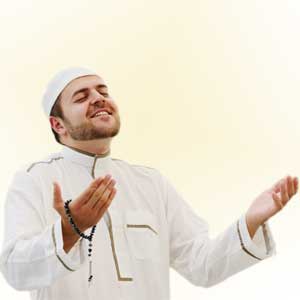



Prophet Muhammad (SALLAU ALAIHE WASALLAM) said: “One who visited my tomb is sure to get my intercession (Shafat)” “One who came only to visit my tomb and paid his homage is entitled to seek my Shafat (intercession)” “One who performed hajj and then came to my tomb is like one who had the privilage to visit me in my lifetime” “One who visited my tomb with intention that he will be in my protection on the day of resurrection and settled down in Madina; I will be his witness and he will be in my intercession” (Shafat) “All the Prophets are alive in their graves and offer prayer”
The Holy Prophet (SALLAU ALAIHE WASALLAM) said:
“One who came to perform hajj but failed to visit my tomb, he did injustice to me”
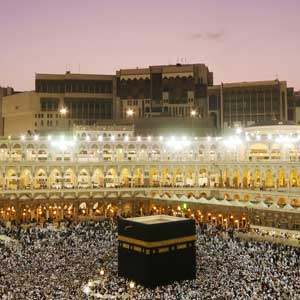

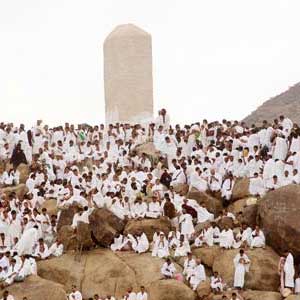

When you intend to visit Madina Munawwara, set aside all your worldly needs and thoughts and describe your intent of visiting the Holy Prophet.
Intent (Niyah)O God, the Beneficent, the Merciful, I intend to travel to Madina Munawwara to pay my respect to the holy Prophet (SALLAU ALAIHE WASALLAM), kindly accept my prayer.”
On your way to Madina, recite Darood as much as you can in paying your respect. Be more respectful and humble, as you approach the holy city. Invocate for yourself. Messenger of God himself said that “God has deputed a group of archangels who convey the Darood to me recited by an intending pilgrim, naming him and that he is sending his compliments and greetings.Likewise when an intending pilgrim reaches near to Madina, the angels approach him, welcome him with praise and pleasantries. Prophet Muhammad (SALLAU ALAIHE WASALLAM) had said “that one who performed hajj and thereafter cane to pay his homage even after my death, is just as he visited me during my lifetime.”
Having reached Madina, the pilgrim, at first, should settle down comfortably at his place of stay. However one is required to be careful enough that nothing indignified occurs. It is the city of Holy Prophet (SALLAU ALAIHE WASALLAM) most revered among the cities, next to Mak`kah. One should not criticize for any shortcoming. If anything hurts, that should be taken with grace and patience. Every nook and corner of Madina deserves your love and veneration.
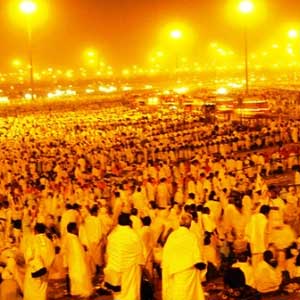

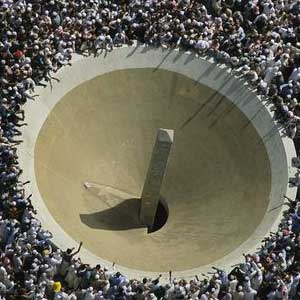

Take bath and dress in best one have. You are to present yourself to the man most beloved of God your master, the best human amongst the humanity.
Walk towards the Masjid in most humble but in dignified way. Offer some alm, if possible. On reaching the doorsteps of the Masjid remove your shoes and enter with right foot first. Recite the prescribed invocation of entering into a Masjid with Darood followed by two units (Rakat) of salutation of Masjid (Eitikaf) then walk forwards Raiz-ul-Jannah. Riaz-ul-Jannah is the space that lies between the Prophet’s tomb and his chair (Mimber). God’s Messenger himself used to say of this spot! “Between my house (now his last resting place) and my mimber lies a garden of paradise. For the faithful to recite a prayer here is tantamount to praying in a corner of Paradise. No wonder, then, that this small space is much sought after by pilgrims, all of whom want to pray there. Sit down wherever you find the place without any hastle and offer the prayer of salutation of Masjid provided it is not the disapproved (Makrooh) time. If a congregation is in progress join it.
Then proceed with utmost respect and humility, eyes gazing down, to the chamber where the Prophet’s tomb lies, reciting Bismillah and Darood. Facing the golden grill with large circular opening with back towards Qibla, offer your Salam, pray for salvation and seek intercession (Shafat) from the Prophet (SALLAU ALAIHE WASALLAM) in low voice taking care that you are in front of the most revered personality of the world for which you have been cherishing the whole of your life. Do not try to look here and there. It is an act of disrespect. If there are two many people crowding this spot the visitor can offer his respect and prayer from some distance too Remember that:
“God and His angels shower blessings upon the Prophet: O ye who believe, bless him and solute him” (33:56)
The Pilgrim can convey to the Prophet (SALLAU ALAIHE WASALLAM) the greeting of his and all those who have asked him to do so. Be careful that the Prophet knows that who is sending his greetings and Darood and the greetings are replied.
The pilgrim then goes over to the tomb of first Caliph Abu Bakr Al-Siddiq (Radi allahu tala unhu)which is a few feet away from that of the Holy Prophet (SALLAU ALAIHE WASALLAM). The pilgrim now goes over to the tomb of the second caliph, Umar Ibn-al-Khattab(Radi allahu tala unhu) just next to that of Abu Bakar Siddiq (Radi allahu tala unhu) where he send his greetings and solute. Before each of these tombs the pilgrim must make salutation and recall the merits of he who lies beneath.
There are seven pillars (Ustawanah) in Garden of Paradise. They all are known as pillars of Blessings. In the first row there are four pillars of red stones. Their names are engraved on them
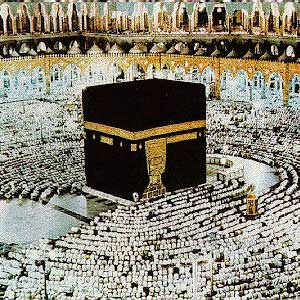

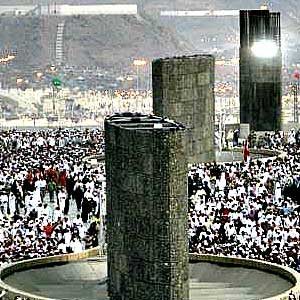

An important and noble part of this exalted journey of hajj is to visit Madina the city of Holy Prophet and pay one’s respect, homage and greetings to the Holy Prophet (SALLAU ALAIHE WASALLAM). Besides the Prophet’s Masjid, there are many more places in Madina and Mak`kah having deep associations with Prophet and early days of Islam the purpose of visiting these holy places is not tourism or any enjoyment but to recall some historical facts about Islam and spiritual guidance. Generations of Muslim faithful have flocked to Prophet’s tomb and to implore God to bless and to reward him according to his merits. A believer should firm his belief to fulfil all the obligatory deeds expected from him since in their fulfilment lies his success in this life and hereafter Remember, complete submission and obedience to Allah and His Prophet (SALLAU ALAIHE WASALLAM) is absolutely essential and a pre-requisite of faith.
Baqee is the cemetery of Madina. Here lies, for the eternal rest, the third Caliph Usman (Radi allahu taala unhu) the wives of the Holy Prophet (SALLAU ALAIHE WASALLAM) the mothers of many believers including Aisha (Radi allahu taala unha) the daughter Abu Bakar Siddiq (Radi allahu taala unhu), Hafsa the daughter of Hazrat Umar (Radi allahu taala unhu), the Prophet’s uncle Hazrat Abbas, Ibrahim and Rukayya the son and daughter of the Prophet, the grandson of the Prophet (SALLAU ALAIHE WASALLAM) Hasan Ibn-e-Ali, the Imam Malik Ibn-e-Anas the founder of Maliki school and a host of companions of the Prophet.
The visitor is always struck by the extreme simplicity of this graveyard of Baqee. The tombs of so many heroes of Islam are marked only by small stones.
The mount of Uhad, which was described by the Prophet as one of the mounts of Paradise is, situated about 5 KM North of Madina. It was at the foot of this hill that the famous battle of Uhad between the infidels and the Muslims was fought that bears the name of Uhad.
The Masjid of Quba also known as Masjid-e-Taqwa (The Masjid of Piety) is the first Masjid of Islam, outside Makkah, put up by the Prophet himself. It was at this spot that the Prophet entered Madina during the migration from Mak`kah. It was also in this Masjid that prophet received the following divine revelation: - “There is a Masjid whose base was founded from the very first day upon piety; it is worthier for those who came to rise (pray) within its boundaries. Within it are men who yarn to be purified and God loves those who purify themselves (Al-Tawba 9:108) Prayer in this Masjid is looked upon as a Tradition and is worth an Umrah. The Prophet was in the habit of going there from time to time. It is preferable to visit this Masjid on Saturday for prayer.
This Masjid falls in way to Quba Masjid from Madina. Prophet Muhammad (SALLAU ALAIHE WASALLAM) offered his first Juma prayer in this Masjid after migration from Mak`kah.
This Masjid is situated on South-West of Manakha. The Prophet (SALLAU ALAIHE WASALLAM) used to offer Eid prayers in this Masjid.
The Prophet (SALLAU ALAIHE WASALLAM) offered the prayer in this Masjid and prayed for the welfare and prosperity of the people of Madina on his way to the battle of Uhad.
This Masjid is situated on the Western edge of mount Sala. During the battle of Ahzab, a large number of infidels attacked Madina and trenches were dug. The Prophet (SALLAU ALAIHE WASALLAM) prayed to God here for three days i.e. Monday, Tuesday, and Wednesday. The prayer was granted and accepted by God and Muslims came out victorious.
This Masjid falls in the way to Uhad. During the battle of Trenches (Khandaq), the Prophet’s tent was erected at this place and he offered the prayer here.
This Masjid is built on the top of a hillock in the valley of Aqeeq. The change of direction of prayer from Bait-ul-Muqdis to Mak`kah was revealed in this Masjid.
Fazih is a kind of wine extracted from Dates. It was at this place that Prophet (SALLAU ALAIHE WASALLAM) and his companions sorrounded the Bani Nusair Tribe of Jews. Hazrat Abu Ayub Ansari with some people was busy in drinking when the revelation banning the wine from Islamic polity was received. The Prophet ordered to break all the wine containers. He also offered prayers here during the siege.
This Masjid is on the eastern side of Jannat-ul-Baqee. Close to the Masjid is the deep foot impression of Prophet’s mule. This Masjid is also known as Masjid-Al-Baghlatah.
Here too the Prophet stayed for some time and offered the prayers.
The Prophet (SALLAU ALAIHE WASALLAM) offered two units of optional prayer here with prostration of exceptionally long duration.
This Masjid is adjacent to Jannat-ul-Baqee. It was actually the residence of Hazrat Abi-Bin Ka`ab. The Prophet (SALLAU ALAIHE WASALLAM) used to come here frequently and offer prayer.
The Prophet (SALLAU ALAIHE WASALLAM) offered prayer here too. There is a cave adjacent to this Masjid where some portion of the Holy Quran was revealed upon the Prophet. During the battle of trenches (Khandaq) the Prophet rested here for eleven nights.
This Masjid is situated towards the north of Bani Qariza. This is also the birthplace of Prophet’s son Ibrahim out of Prophet’s wed lock with Hazrat Maria Qibtiyah. The Prophet (SALLAU ALAIHE WASALLAM) offered the prayers in this Masjid too.